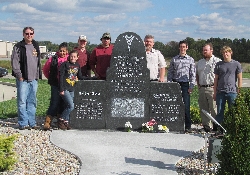Emergency Management Students Get Hands-On Experience in Harrisburg; Field Project Assists Southern IL Community Hit by Leap Day Tornado
October 29, 2013

Dr. Jack Rozdilsky and WIU emergency management students with Saline County Emergency Management Agency Officials at the memorial commemorating the eight deaths from the 2012 Leap Day Tornado Disaster in Harrisburg, IL.
[Download Print-Quality Image]
MACOMB, IL — For Western Illinois University emergency management major Hannah Beasley, a recent field trip to Harrisburg, IL—the southern Illinois community that, on Leap Day 2012, experienced an EF-4 level tornado, the largest natural disaster in Illinois last year—was more than just a way to complete an assignment or take part in an experiential class project. For Beasley (who is from Linden, CA, but grew up in a mobile home in Kentucky), thinking of the terror Southern Illinoisans experienced that February 29 reminded of her own childhood experiences involving tornado activity.
"Going to Harrisburg was a very personal assignment for me because I grew up in a trailer in Kentucky. We had no storm shelter to go to when the sirens sounded, and I remember sitting in the bathtub with my sisters with our bike helmets on, scared to death because we had nowhere else to go," Beasley explained. "Having community shelters so the less fortunate can be shielded from the storm is something I support with all that I am."
Beasley was part of a group of eight students WIU Emergency Management Professor Jack Rozdilsky took to Harrisburg to provide them with hands-on disaster field experience and to assist the Harrisburg community with disaster recovery. The students were not only there to experience the conditions of a natural disaster site, but they were also there to help examine and analyze possible locations for tornado shelters.
Rozdilsky said the concepts covered in the field project are based on his qualitative study, "Disaster Management with Limited Local Resources: The 2012 Illinois Leap Day EF-4 Tornado" published earlier this year. (His research was funded by a grant from the University of Colorado Natural Hazards Center through its Quick Response Grant Program, which is funded by the National Science Foundation. It is available online as Quick Response Report #233 at www.colorado.edu/hazards/research/qr/qrpubs10s.html.) He also presented his findings at the National Tornado Summit last March. The findings, he noted, will help provide small, rural, oftentimes economically challenged, communities—such as Harrisburg, with a population of around 9,000, and many communities in the state and across the Midwest—with helpful information about how to manage future tornado disasters.
One of several journeys he has made for his ongoing Leap Day EF-4 Tornado research, Rozdilsky's Oct. 17-18 trip with his emergency management students provided them with the opportunity to visit with staff at the Saline County Emergency Management Agency (SCEMA) during week 85 of the recovery effort.
"The Leap Day Tornado hit the ground with a force of 175-180 miles per hour, left eight people dead, injured many others and damaged close to 450 homes. After the disaster, a need was identified to develop community tornado shelters at public facilities where mass gatherings take place, such as fairgrounds or sports facilities," Rozdilsky explained. "The students gathered information related to the creation of shelters and field sites where they could potentially be built. It's possible, next year, the tornado shelters the students were planning may be placed in the community as a part of a mitigation project," he added.
Nick Swope, a graduate student in health sciences (public health) who accompanied Rozdilsky and the emergency management students, said having the opportunity to see the recovery effort first hand is extremely beneficial.
"During our visit, Saline County Emergency Manager Allan Ninness also took us through the incident and response process, where we learned how Harrisburg undertook setting up security areas, placing restroom facilities, managing volunteers and processing and allocating donations," he said. "There is absolutely no substitute for field experience. You get so many little bits of wisdom, for example, like using colored wristbands to organize volunteers. Things like that are so small, are so very practical, but won't necessarily be found in a textbook or pamphlet."
Beasley echoes Swope's feelings about having the opportunity to participate in field experiences such as the one in Harrisburg.
"We learn a great deal in our classes, but one can only learn so much in the classroom. There comes a point in one's education it becomes necessary to have hands-on, practical learning you can only get in the field, especially in our line of work," Beasley said. "Everything you see and hear at emergency management field sites provides you with a chance to learn and grow, for you to take that information with you and use it in your future. You learn from what others have done right, or you may learn that you need to try something different and learn from that, as well."
For more information, contact Rozdilsky at (309) 298-1621 or via email at JL-Rozdilsky@wiu.edu. Learn more about WIU's emergency management bachelor's degree program—one of only 15 of its type in the U.S.—
at www.wiu.edu/coehs/health_sciences/undergraduate_programs/emergency_management.php.
Posted By: Teresa Koltzenburg (WIUNews@wiu.edu)
Office of University Communications & Marketing

Connect with us: